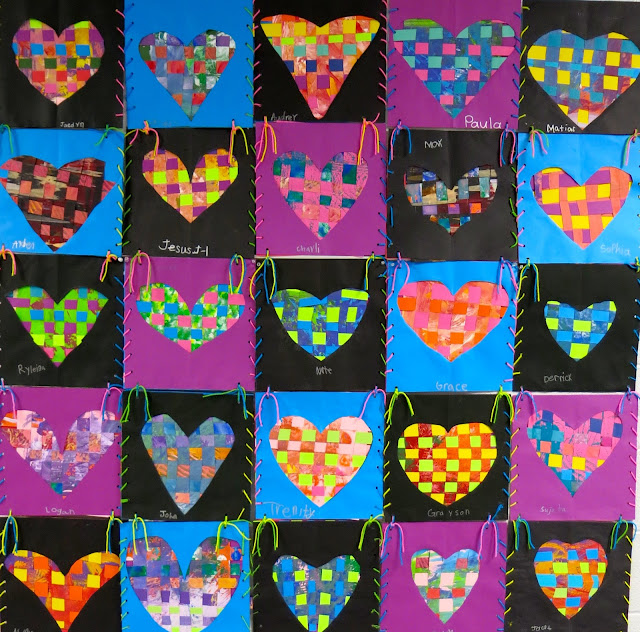It's official, ya'll: School's Out for the Summer! And it really truly couldn't have come at a better time. Our school wide art show was a week before the last days of school which was a good thing since I was basically a useless puddle of exhaustion after the fact. I'm just glad that my Stress-Related Art-Show Eyebrow-Twitch finally stopped as I was tired of the dude at Starbucks thinking I was hitting on him.
Before I share with ya'll the amazing artwork of my kindergarten through 2nd grade students (3rd and 4th grade kiddos and clay projects to be shared in another photo-laden post), I have just gotta give a great big
Thank You!
to the dozens of parent volunteers that popped in everyday for two weeks leading up to the art show to hang the artwork. That's right, they hung everything that the kids created all year (my rough estimate was about 2300 masterpieces). I'm super lucky to have such amazing support from the parents of my young artists. Ya'll are the bestest!
Okay, without further ado, I present to you the masterpieces outta Kindergartenland!
In kindergarten, I like to start the school year with a great big fat unit on line. We sculpt with lines, paint a pattern of lines and create an abstraction of lines. These bright and happy paintings are always a favorite of mine.
Another fave this year was clay butterfly sculptures. I really love that crayon/watercolor technique for the little ones. It seemed to add more depth to their texture than glaze would. That painting on the right is another project from our line unit.
For Read Across America week, I wore my Don't Let the Pigeon Drive the Bus dress and we created these cuties. This was a big hit with the kids and parents alike. We had a lot of fun trying out our wet-on-wet watercolor skills with this project. Look below and you'll see how they did that in the background of their work.

One thing I love about having the parents hang the artwork is that each hangs the pieces a little differently. I find that this makes for more dynamic displays from class to class. Foxy lesson here and Starry Night Collages here.
This year, I made signs for the art show that were inspired by that AMAZING art teacher over at Painted Paper. When I saw her post on art show signs, I knew I had to use our stash of leftover painted papers to make my own.
Onto the 1st grade artwork. The little ones were so busy this year! One of our most recent masterpieces were these koinobori that we were able to hang in a large bank of windows. Details on that fun and quick lesson here.
My 1st grade started the year creating those hilarious Viking Self Portrait collages with Rebecca, my former student teacher (who is RIGHT NOW interviewing for her own art teacher gig, wish her lucky, ya'll!). Details on those Starry Night Collages here and Party Pandas here.
Our second round of self-portraits were of a Japanese theme with ourselves dolled up in kimonos. Details on that lesson here.
When I was absent for a couple of days attending the NAEA conference in San Diego, I left my "But I'm Not an Artist!" sub directions on teaching the kids to draw these pandas. And, much to her surprise, her drawings, as well as the kids, turned out great! This also meant that I could come back to work with a lesson already started and simply bust out the watercolor paints for the kids to finish them. Details on those ceramic stars to come.
One final look at 1st grade before we move onto the...
Again, the idea for these signs came from Painted Paper. Each set of signs was hung right above the hallways leading to that grade level.
I really loved the work that my 2nd graders created this year. Some of my favorites were their circle loom weavings and their cherry blossom paintings.
Every year, I have my 1st through 4th grade students right an autobiography to hang with their artwork. This also proved to be a great sub lesson when I was out for a different occasion. Can't remember what. Booze Cruise, maybe? Wishful thinking. My 2nd grade also took part in the Viking and Kimono fun.
We hang ALL the artwork that the kids have created ALL year. Which means that one class can take up a whole lotta wall space. I have yet to find what sticks the best to cinderblocks in the muggy pre-summer heat of our halls. We've tried every kind of tape, that blue sticky stuff by Dapp, double-sided tape by 3M and hot glue. While hot glue works great, it's a headache trying to get it off the walls. Next school year, I'm begging and pleading for more cork strips.
Paper marbling was a fast and fun project to teach about the Japanese art of Suminagashi.
I liked this lesson so much, I blogged about it twice.
I've always struggled with a circle loom weaving lesson where I loved the results as much as the kids did the process. In the past, we wove on CD's and unpainted white plates. The results were fine...but when we painted the plates this year, it seemed to take the weaving to a whole new level.
And there you have it, ya'll! The 2-dimentional masterpieces by kindergarten through 2nd grade. Stay tuned in the next coupla weeks as I share the rest of the art show as well as lessons with ya.
Until then, how do you know it's officially summer? Well, it's 1pm and I'm still in my pajamas! May your days be filled with pjs and craft projects, teachery folk! For the rest of ya, take a day or three off, you've earned it. Tell your boss a crazy art teacher said so!














































































